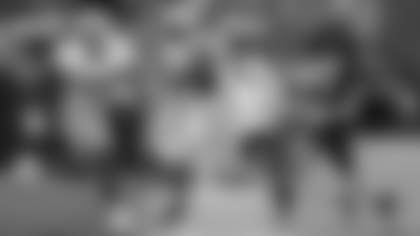Steve Sabol was a football guy. And among football guys, there is no higher compliment.
Sabol passed away after a courageous 18-month battle with brain cancer. He fought the fight the best he could and then it ended, but his influence on pro football will never end.
Who in America has not been influenced by the films produced by NFL Films over the past seven decades? Virtually every football fan in America has seen these films over and over, and they all look just as good all the time.
NFL Films invented the steady cam, the slow motion shot of the football in spiral coming toward you, was the first to go inside the locker room, right here in Denver with Lou Saban's Broncos in 1968.
Bronco fans — you know the shot of Lou Saban on the sideline, commenting to his offensive line coach and dear friend Whitey Dovell, "They're KILLING me, Whitey, they're killing me…"
That was Steve's crew, and Steve's idea.
How about all those wirings of all those players? You have seen them, and they have grown the game and made it so loved and in fact, so valuable.
Remember the great hit by Steve Atwater on Kansas City's Christian Okoye in that Monday night game? My lifelong friend Bob Smith, who has 27 individual Emmys for NFL Films (yes, that figure is correct) and I had to convince Steve to wear the wire. And Broncos visual history would not be the same without it.
But Steve Sabol was the father of the wire, and Bob Smith was the attending physician at its birth.
We were always happy to go along.
Remember head coach Mike Shanahan being wired for seven straight playoff games, all victories, on our way to back-to-back Super Bowl wins in 1997 and 1998? He was the first coach to go along with that for that many straight playoff games (and wins, which did not hurt the streak), I was the first PR guy to get his coach to concede to it. One guy did all the wires, Bob Smith, for one organization, NFL Films, and one guy had the foresight to push forward and ask, prod, cajole the teams, the owners, the coaches— Steve Sabol.
The first guy I called when I got the news was former/retired Broncos General Manager John Beake, and we shared some moans and wails. John used to come with me every year when I went back to Films to review the Broncos annual highlight film — I worked with Bob on scripts and content, and John just wanted to make sure we did not accidentally feature players whose futures were tenuous.
But the night before, John and Steve and Bob and I would go to Bookbinder's, the legendary Philadelphia restaurant, and share football stories over food and drink — but more football stories than anything.
John earned his early coaching spurs when he and Joe Paterno were grad assistants together, and Steve learned the game — and how to hustle owners and coaches for "the best shot" at the knee of his father, Ed, who most deservedly is in the Pro Football Hall of Fame.
Those were great nights, is all I can say. Too many stories to relate, an entire book spewn out at the dinner table.
But it was all football, all the time, for Steve Sabol.
Most people do not know this, but Steve had perhaps the best individual collection of historic pro and college football magazine covers in America. But Steve did not have them locked up in an attic somewhere — they were framed and on display, still to this day, on the walls of NFL Films headquarters. He created a genuine museum on the walls of NFL Films, and he possessed so many framed objects that he would at times rotate them to give some exposure to all.
The cafeteria of the previous NFL Films building had a corner homage to "The King" — a corner table framed by a huge photo of Elvis Presley, the King of Rock and Roll and a favorite of Steve's, on one wall, and on the opposite was a huge action picture of "the King," halfback Hugh McElhenny. His nickname was The King, and I will leave it to the reader to check him out.
But he was The King, and every football guy who loved the game back in the day knew it.
How fitting that there was someone like Steve Sabol to pay proper tribute.
Sabol had some Colorado roots, as few know.
He came out here to go to Colorado College, where he was a backup, backup running back. He had Big Ed's sense of flair and theatrical, and to try to make himself seem tougher and thus move up on the depth chart, Steve for awhile tried to list himself as coming from Possum Trot, Miss., (which he made up—the birthplace, not the town), figuring that birthplace made him seem tougher to all.
After college Steve joined his dad Ed in the family business, working as a cinematographer for his dad at Films starting in 1964.
Sabol has been honored so many ways, so many times, with so many awards, that I will leave it to the reader to check those figures out elsewhere.
But no single family not named Halas or Mara or Rooney ever had as great an influence on the great game of pro football as did the Sabols.
Steve Sabol was a football guy.
Rest in Peace, Steve.
Football flags fly half way up today, from the biggest city to Possum Trot, and in the heart of every fan.






